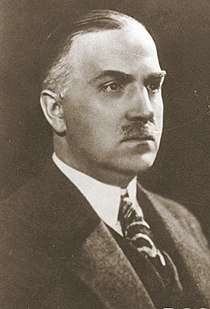Jan Czochralski
Jan Czochralski (/ˈjæn tʃɒxˈrɑːlski/ YAN chokh-RAHL-skee, Polish pronunciation: [ˈjan t͡ʂɔˈxralskʲi]; 23 October 1885 – 22 April 1953) was a Polish chemist who invented the Czochralski process,[1] which is used for growing single crystals and in the production of semiconductor wafers. It is still used in over 90 percent of all electronics in the world that use semiconductors.[2] He is the most cited Polish scholar.[3]
Jan Czochralski | |
|---|---|
 Jan Czochralski ca. 1910 | |
| Born | 23 October 1885 Exin, German Empire |
| Died | 22 April 1953 (aged 67) Poznań, Poland |
| Nationality | Polish |
| Citizenship | Polish and German |
| Alma mater | Charlottenburg Polytechnic in Berlin |
| Known for | Czochralski process |
| Spouse(s) | Marguerite Haase |
| Scientific career | |
| Fields | Chemistry, Metallurgy |
| Institutions | Warsaw University of Technology |
Life and career
Czochralski was born in what was then Exin in the Prussian Province of Posen, German Empire (now Kcynia, Poland). Around 1900 he moved to Berlin, where he worked at a pharmacy. He was educated at Charlottenburg Polytechnic in Berlin, where he specialized in metal chemistry. Czochralski began working as an engineer for Allgemeine Elektrizitäts Gesellschaft (AEG) in 1907.
He discovered the Czochralski method in 1916, when he accidentally[3] dipped his pen into a crucible of molten tin rather than his inkwell. He immediately pulled his pen out to discover that a thin thread of solidified metal was hanging from the nib. The nib was replaced by a capillary, and Czochralski verified that the crystallized metal was a single crystal. Czochralski's experiments produced single crystals a millimeter in diameter and up to 150 centimeters long. He published a paper on his discovery in 1918 in the Zeitschrift für Physikalische Chemie, a German chemistry journal, under the title "Ein neues Verfahren zur Messung der Kristallisationsgeschwindigkeit der Metalle" [A new method for the measurement of the crystallization rate of metals], since the method was at that time used for measuring the crystallization rate of metals such as tin, zinc and lead.[4] In 1948, Americans Gordon K. Teal and J.B. Little from Bell Labs would use the method to grow single germanium crystals, leading to its use in semiconductor production.
In 1917, Czochralski organized the research laboratory "Metallbank und Metallurgische Gesellschaft", which he directed until 1928. In 1919 he was one of the founding members of the German Society for Metals Science (Deutsche Gesellschaft für Metallkunde), of which he was president until 1925. In 1928, at the request of the president of Poland, Ignacy Mościcki, he moved to Poland and became the Professor of Metallurgy and Metal Research at the Chemistry Department of the Warsaw University of Technology.[5]
After the war, he was stripped of his professorship by the communist regime due to his involvement with Germany during the war, although he was later cleared of any wrongdoing by a Polish court. He returned to his native town of Kcynia, where he ran a small cosmetics and household chemicals firm until his death in 1953.[6]
Remembrance
As a way to commemorate him, a number of places in Poland were named after Jan Czochralski including schools and streets in such cities like Gdańsk, Poznań, Bydgoszcz and Wrocław.
In 2009, the Polish Post issued a series of four commemorative stamps. The stamp with a denomination of PLN 1,55 depicted Jan Czochralski.[7]
In 2012, the Polish Parliament passed a resolution to name 2013 as "The Year of Jan Czochralski".[8][9]
In 2016, a team of Polish mineralogists led by Łukasz Karwowski from the Silesian University and Andrzej Muszyński from the Adam Mickiewicz University named a newly-discovered mineral Czochralskiit in honour of the Polish chemist. It was discovered during scientific works in the Morasko Meteorite Nature Reserve.[10]
In 2018, a comic book by Maciej Jasiński and Jacek Michalski entitled Jan Czochralski. The Man Who Changed the World (Polish: "Jan Czochralski. Człowiek, który zmienił świat") was officially published.[11]
In 2019, a commemorative IEEE Milestone plaque honouring Czochralski's scientific achievements was ceremonially unveiled at the Warsaw University of Technology.[12]
In 2019, a square in front of the Mill of Knowledge Innovation Centre in Toruń was named in memory of Jan Czochralski.[13]
Publications
- Moderne Metallkunde in Theorie und Praxis, J. Czochralski, published by Springer, Berlin, 1924.
See also
- List of Poles
- Timeline of Polish science and technology
References
| Wikimedia Commons has media related to Jan Czochralski. |
- "Czochralski Process". Retrieved 18 November 2019.
- "Scientist who laid the foundations for Silicon Valley honoured at long last". Retrieved 18 November 2019.
- Pajaczkowska, Anna (June 2001). "Professor Dr. Jan Czochralski - An Inventor". Newsletter of the German Association for Crystal Growth. Deutsche Gesellschaft für Kristallwachstum und Kristallzüchtung (73): 30. ISSN 2193-3758. Archived from the original on 2012-07-08. Retrieved 22 November 2012.
- J. Czochralski (1918) "Ein neues Verfahren zur Messung der Kristallisationsgeschwindigkeit der Metalle" [A new method for the measurement of the crystallization rate of metals], Zeitschrift für Physikalische Chemie, 92 : 219–221.
- "Profesor Jan Czochralski (1885-1953)". Retrieved 18 November 2019.
- "Nazi Collaborator or Resistance Fighter: The Extraordinary Story Behind The Man at the Core of The Digital Revolution". Retrieved 18 November 2019.
- "Znaczki z 2009 roku". Retrieved 19 November 2019.
- "M.P. 2012 poz. 990". Retrieved 19 November 2019.
- "Zakończyło się 28. posiedzenie Sejmu". Retrieved 19 November 2019.
- "DWA NOWO ODKRYTE MINERAŁY W METEORYCIE MORASKO". Retrieved 19 November 2019.
- "Komiks Jan Czochralski". Retrieved 19 November 2019.
- "Scientist who laid the foundations for Silicon Valley honoured at long last". Retrieved 18 November 2019.
- "Plac im. prof. Jana Czochralskiego". Retrieved 19 November 2019.
External links
- http://www.janczochralski.com
- https://zyciorysy.info/jan-czochralski/
- https://web.archive.org/web/20031024215816/http://www.itme.edu.pl/czochralski.htm
- http://www.tf.uni-kiel.de/matwis/amat/elmat_en/kap_6/advanced/t6_1_4.html
- https://web.archive.org/web/20160303234728/http://www.ptwk.org.pl/php/patron.php?p=eng,pa